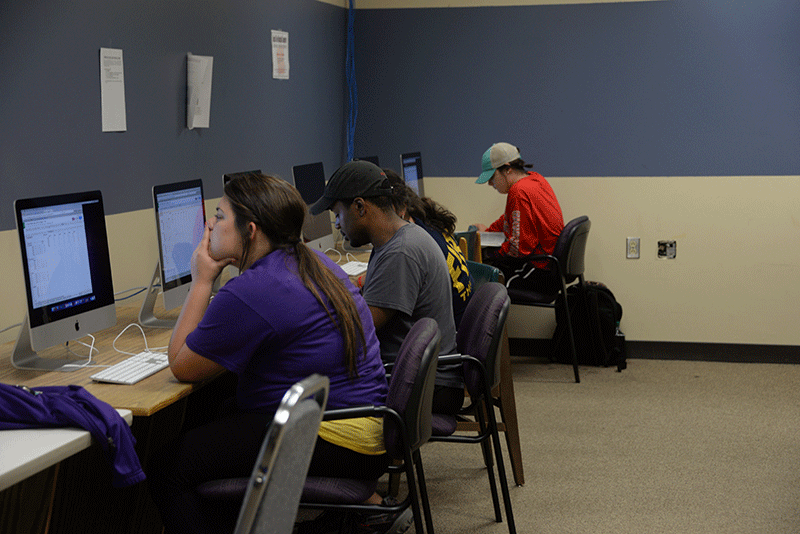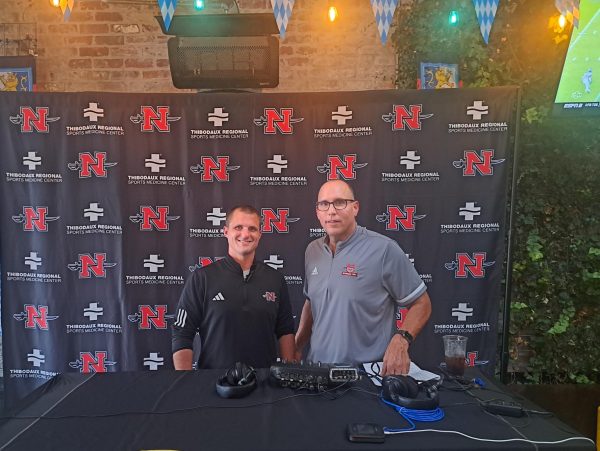Wifi service attack raises concerns over internet satisfaction
Photo by: Natalie Authement
Students study and complete school work on the computers in the Ellender lab in the library on campus on Tuesday, September 8th.
Nicholls State University’s Wi-Fi was affected by a Denial of Service attack, which stalled network activity and got the students discussing their satisfaction with the Internet once again.
The University of New Orleans came under a DOS attack on Aug. 27. Louisiana Optical Network Initiative provides Internet connection to many campuses in Louisiana, including University of New Orleans, University of Louisiana and Nicholls State University.
A DOS attack is an attempt to make a network or machine unavailable to it intended users. The attackers achieved this by creating a large amount of traffic and consuming most of LONI’s available bandwidth, the bit-rate of consumed information capacity in metric multiples of bits per second.
“Nothing has been publicly released. LONI’s Internet connection was affected by the attack on UNO, which shares a connection with Nicholls and other colleges,” Charles Ordoyne, chief information officer, said. “They disconnected UNO from the network until UNO identified where the problem was, which allowed us to get our service back. It looks like the attack was internal to UNO and that’s all they shared with us.”
If an attack on service were to occur physically or on hardware, there are preventatives to alleviate the problem and it would only hamper Internet connection. A software attack, however, leaves fewer precautions and can cause more than small Internet connectivity problems.
“Our network administrator has been in contact with LONI, telling us what the interruption was about. A hardware break in service wouldn’t be a break in connectivity, but a software attack that generates a lot of traffic does affect our connections,” Ordoyne said.
These Wi-Fi conditions have brought to light how students feel about their Internet connectivity. On a normal day, the wireless network averages approximately 4,000 to 4,500 devices simultaneously connected.
“It’s good enough to do homework. It’s not lightning speed or anything but it gets the job done, and that’s all I really care about for Internet purposes on campus,” Paige Garcia, former resident and marketing senior, said.
Internet satisfaction is still a problem for some students, especially residents who use the Internet for various activities including contacting home, social media and streaming videos. In the fall, Student Government Association will present a proposal to the Tech Fee Committee to fund the replacement of our edge security firewall.
“The way the Tech Fee committee works is, usually in October, Students and Faculty submit grants that are accumulated in the Student Sub-Committee score,” said Ordoyne. “We’ve been working with SGA on how to get funding, so we may be looking at November. Once they are approved we can start buying the equipment. Our current firewalls were purchased in 2007-2008.”
A firewall is a part of a computer system that is designed to block unauthorized access while permitting outward communication.
“The firewall right now is outdated as far as its age, capabilities and throughput. I think immediately when the hardware is in place, we should go to 1 gigabyte instead of the 500 megabytes standard currently being used.”
Currently, the largest consumer of bandwidth on campus is streamed videos. A large number of students, especially residents, use Netflix, Youtube and other streaming platforms.
“Streaming video is by far the biggest bandwidth usage. It’s like 75-80 percent of the bandwidth. That’s okay, it’s just we have to make sure we can accommodate it,” Ordoyne said.
Students who are having device problems or Internet connectivity problems can fill out a work order to the IT department.








